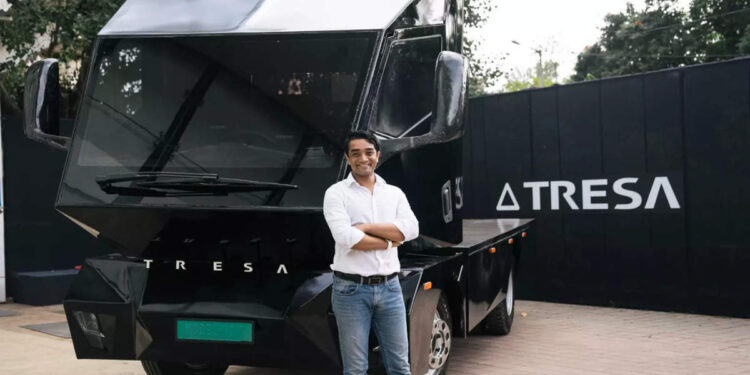
New Delhi: Electrification trend has seen a boost in recent years, though the electrification varies from segment to segment. Highest penetration of EVs is seen in two wheelers and the least can be in heavy commercial vehicles. However, the medium and heavy commercial vehicles makers have decided to bring this trend on the road.
Several OEMs, start-ups, and Tier 1 suppliers too have started taking steps towards tapping the electrification opportunity in the CV space. Such as Kalyani Powertrain, and Volvo Eicher Commercial Vehicles have begun their research and trials. Startups like Tressa Motors are ready to bring their first heavy duty commercial vehicles on the road by late 2025 or early 2026.
Tresa Motors, founded by Rohan Shravan, Founder CEO and CTO of Tresa Motors, starts from a range of 18 tonne to 55 tonne vehicles. “We are using our own motors, gearboxes, batteries, battery packs, electronics, and inverters. For the components most of the OEMS depend on imports. We are making them in house,” Shravan said while talking about the making of the vehicle.
This heavy commercial vehicle maker currently has one model titled ‘V’, and is working on model ‘B’. Both the models are designed for 200, 400, and 600 km range. The 18 tonne model V works on 250 kw motor, while 55 tonne model B works on 350 kw model. Tresa has today unveiled a new variant VO. 2 in its ‘V’ range.
This truck is not only an electric truck aiming to bring an alternative for fossil fuel buyers but also an advanced electric vehicle consisting of cameras and a lidar system to know the position of the heavy vehicle in 3D because of the data sensing technology that Tresa uses.
About the pricing of the trucks Shravan said, it is going to be around INR 35 lakh – INR 50 Lakh for 200 km range, the cost for normal diesel truck, accordingly the cost will vary. Recently, Tresa has secured preorder of 1,000 trucks from JFK Transporters.
Autonomous parking in HCVs
“I can park wherever it’s required and that’s where autonomous parking comes in. With the sensors and the radar system that we have, it is capable of autonomy in future,” Shravan told ETAuto. However, he has made it clear that the company is not focused on autonomous driving. It has brought autonomous features to avoid road accidents. He further added, autonomous driving is not appropriate for current Indian roads, and the technology (autonomous driving) is yet to be matured.
“In India you don’t have roads or lanes. And for it to be totally autonomous in India, it would need a lot more training, and a lot more data to be collected. That’s the data that we need to collect before we start putting it,” he said.
About the competitors in the market, Shravan said, there is no e-HCV out, and those who have brought it on the roads have retrofitted their own old vehicles. “They’ll take the engine out, put the motor there. After the motor you’ll have a eleven speed gearbox, then a nine meter long shaft, and then you have the driveway differential. And then, when you do a retrofit, you are carrying forward a lot of old systems. That is going to be the mounting, the housing and different stuff that adds a lot of weight,” he added.
“Ours is probably the only company in the country which can make its own motor and inverter at the power we are talking about (HCV),” said Rohan. Its in-house motor also brings an opportunity for them to make themselves apart from others. However it also costs them a fortune along with their efficiency targets.
The startup is working on 800 volts rather than the general 400 volts. Its target is to make the most efficient truck along with a high mileage.
Road trials
The company is set to do its on-road ground trials, for which it has got 5 trade certificates for different vehicles. Once the trials cross million km on the road, which it expects to complete by 2025, the company will then commence production. “That’s going to be the real test for us on the overall durability of the vehicle, overall targeting, and the overall performance numbers that we are looking at.”
He added that the trials have already been commenced with the undisclosed partners, who will aid to scale the products. The company currently has 4 partners.
The road trials are conducted to understand the partner’s needs. He explained it with an example. “We load the equivalent amount of load on our truck and go from point A to point B. And before going we share it with our partners. This is the overall power drain that we’re expecting. Then we match it with the actual trial result etiquette and whatever difference is there, we try to optimize that. Let’s say, a motor on a table versus on an Indian road, there is a lot of difference.”
“So there are a lot of parameters that we need to optimize. How fast the battery is depleting, how fast the battery is heating up or the motor is heating up, how can we control the coolant flows? So all of that technical data get captured remotely and it’s literally a computer on a wheel. So whenever the truck is on the road, we get the data through the cloud to understand how it is behaving,” he added.
The engineers and analysts try at the company level to understand if it is expected or there’s some anomaly.
Fund-raising
The company has planned to raise around INR 500 crore to INR 1,000 crore in the coming second quarter, September to December 2024. It has already raised some funds in the past from the internal circle and private investors (friends, family, and relatives), and is ready for the coming next investment rounds. However, the CEO and CTO mentioned these are linked to the performance of the vehicle on the ground, how good it is doing, how to put the trials.
Charging infrastructure
About the range it can cover in one go, the founder said, “that’s why working with the clients are important. When a client is buying truck to meet a range, you need to know from them why they are buying it. For that we need to optimize.”
The company also provides its own charging network available with them in the B2B (Business to business) sector as the public network, however, they can switch further to B2C in future too.
Will Tresa establish its presence in this segment with its technologically advanced heavy commercial truck, competing against tough and leading competitors?















